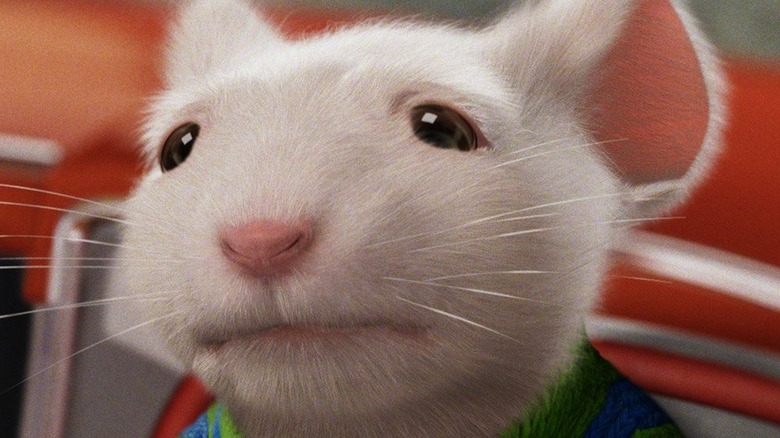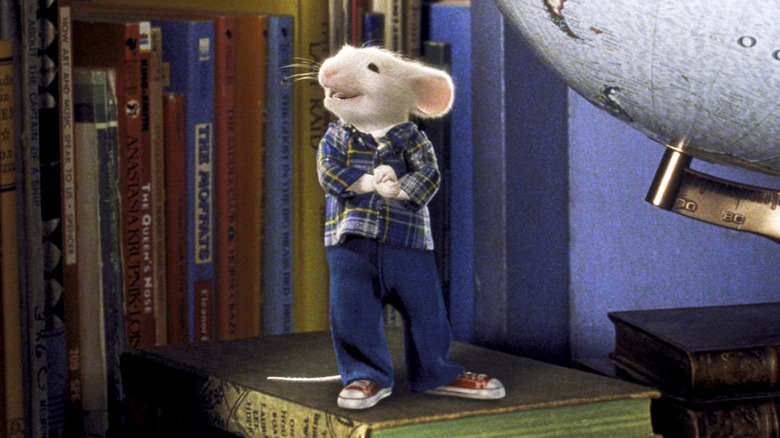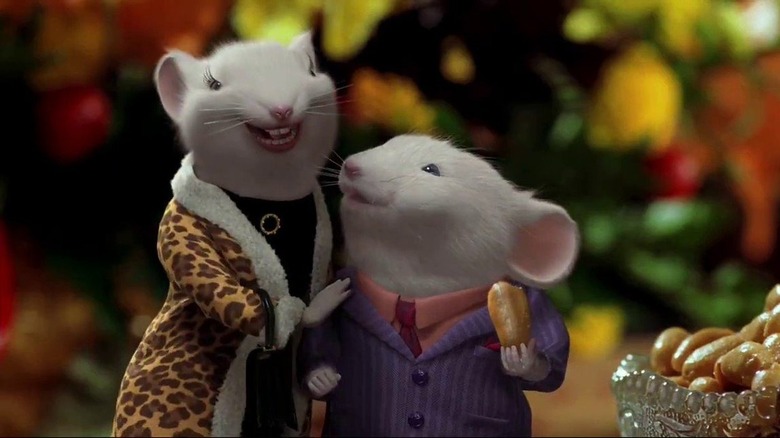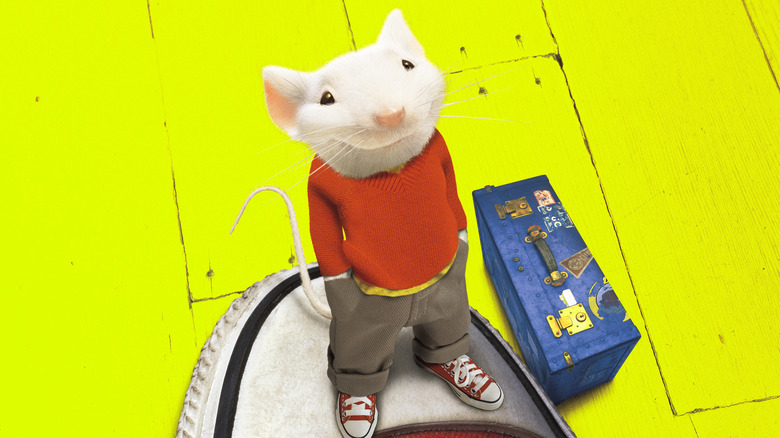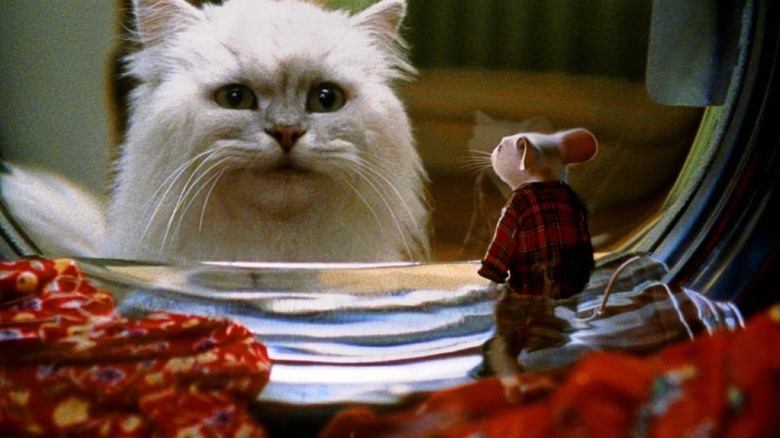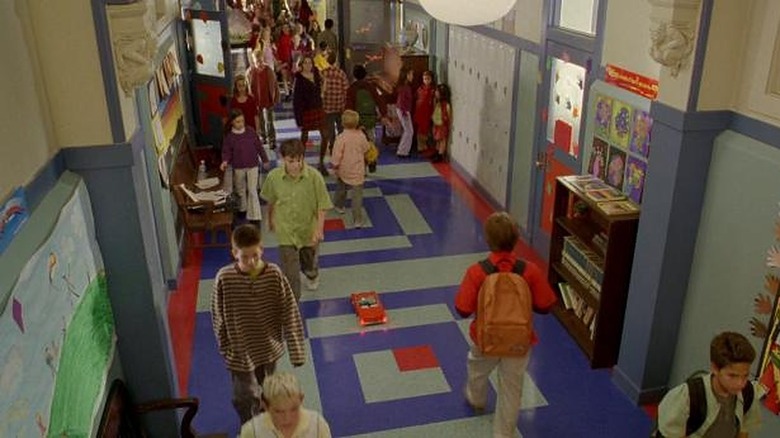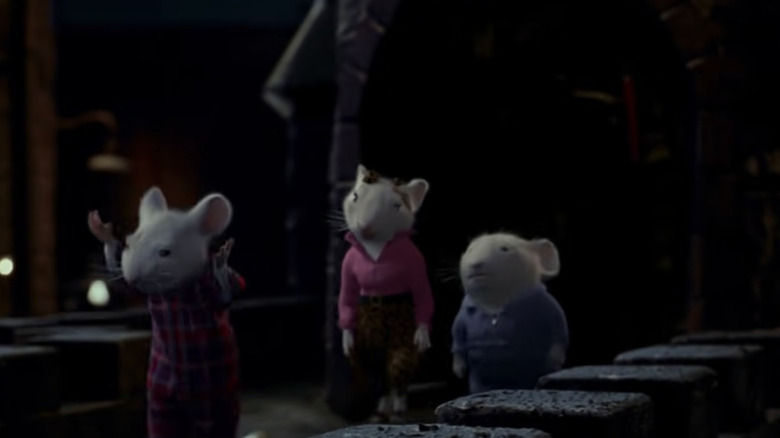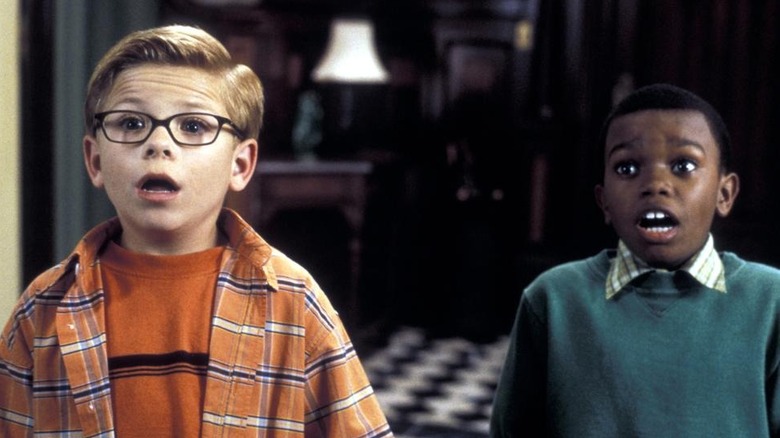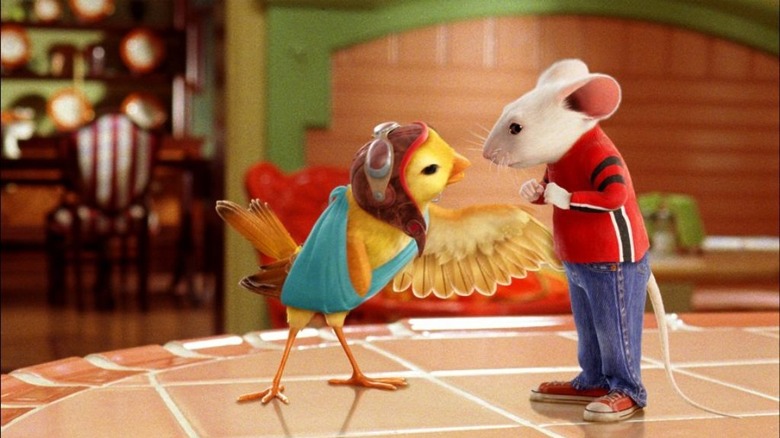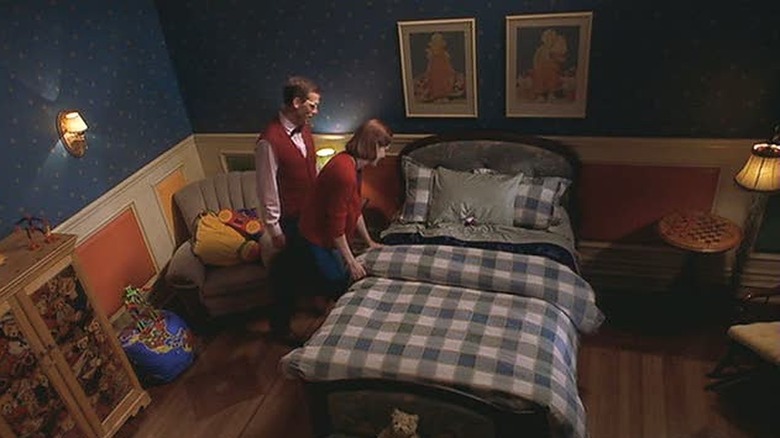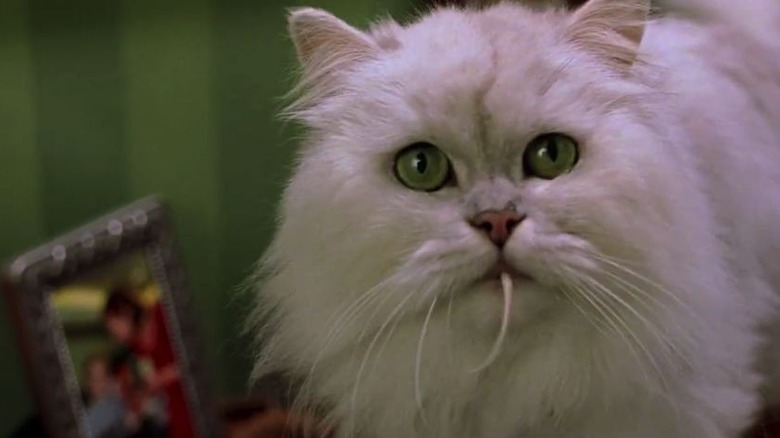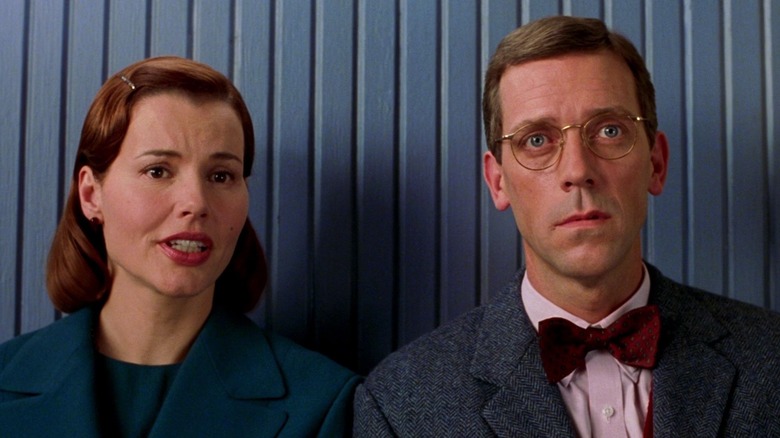Things Only Adults Notice In Stuart Little
1999's "Stuart Little" is about as straightforward as kids' movies come. A family adopts a talking mouse as their son, adventures ensue. But despite this pretty simple (if very weird) premise, many things about "Stuart Little" go over younger viewers' heads. For one thing, if you've ever lived in the city, you know that you don't have to adopt a mouse to cohabitate with them. So why the heck do the Littles adopt a mouse as their son when there are at least a dozen kids who need homes at the orphanage? It's not like Stuart takes up a whole lot of space and food — they could definitely afford to scoop up Stuart and a child in need.
The bizarre details don't stop there. "Stuart Little" offers quite a few more oddities that the little ones might not clock. For instance, have you ever noticed that the movie's cats deploy mob phrases? Did you catch the way the film cleverly avoids Barbie-related copyright issues? Between New York City status symbols, adoption snafus, and bizarre interspecies mingling, "Stuart Little" is full of things only the adults in the audience notice. Which of these details did you miss when you first watched the movie as a kid?
Ken, who?
You've probably noticed product placement in your favorite shows or movies. Whether it's Razzles in "13 Going on 30" or Pop-Tarts in "Gilmore Girls," it tends to be a pretty un-subtle act. However, while many movies and TV shows are more than happy to partner with real-world companies for a hefty payday, some go a different route. The slight alteration of known brands is just as jarringly apparent as blatant product placement — take, for instance, the use of Pear electronic devices in "iCarly." It doesn't take a genius to realize that this tech is a not-so-subtle ripoff of Apple.
That brings us to "Stuart Little." What exactly does New York's finest mouse rip off? Well, first you have to ask any '90s kid who the power couple of the decade was. No, it's not Buffy and Angel — it's Barbie and Ken, of course! When the Little family shops for new clothes for their mouse son, who else but Ken is fashionable enough to provide Stuart with snazzy suits and flannels? Since the film couldn't actually use a Ken doll, the iconic boy toy is re-christened "Ben." Subtle, right? It does the trick, and most kids are none the wiser that the movie has ripped off Barbie's boo.
Adoptive parents are real parents
Let's get one thing clear: Adoptive parents are real parents. While we certainly didn't examine language back in the '90s as we do today, calling birth parents "real" parents was not exactly a classy move even then. For a movie that otherwise tries to normalize adoption — mouse son or no mouse son — "Stuart Little" sure does embrace this phraseology with open arms.
When Stuart wants to find out about his birth parents, the movie calls them his "real parents," and no one seems to bat an eye. Now, it's clear that the Littles treat Stuart just the same as they do George. Though the film never states that George is biologically a Little, it's heavily implied. If anything, they're a little (pun intended) more protective of Stuart, given the fact that his peers can literally crush him with their feet.
The bottom line? It's not cool to undermine the love and care adoptive parents like the Littles give to their children. At the end of the day, adoptive parents want their children so much, they're willing to go to the ends of the earth to adopt — which isn't as easy a process as the film suggests. You definitely don't get to walk to an orphanage and take home a kid the same day. It's a little more complicated than that, to say the least.
RIP, Stuart
Sure, Stuart is pretty cute, and possesses a refreshing degree self-awareness. But is there anything special, biologically speaking, that sets him apart from other mice in this universe? The canon points to "no." While it may seem extraordinary that Stuart, a mouse, can talk, we see a myriad of animals talk in the "Stuart Little" movies, including Snowbell, Margalo, and the mice who pose as Stuart's fake parents. Given that all animals seem to talk in this universe, there's no reason to believe the mice don't have average life expectancies, since nothing magical seems to be at play.
Mice tend to live for approximately two years on average, with some rarer types living longer. This timeline doesn't really add up for our ol' boy Stuart, who appears to be a common mouse. When we learn about the deaths of Stuart's birth parents, the social worker mentions that they've been dead for years. That means that Stuart is at least over two years old already. Given the fact that he starts off the film as the orphanage's tour guide, having been there the longest, the audience is left to believe that Stuart is around the same age as George. But mice don't age at the same rate humans do. He would already be an old man in the first movie, in mice years, and realistically should have died before the sequel. RIP, Stuart.
The cats are the mob
Most kids haven't gotten to their "The Godfather" phase yet, at the age they watch "Stuart Little" — but that didn't stop writer M. Night Shyamalan from including some references to the crime classic in his screenplay. Snowbell's intense fear of his cat friends is telling enough, but when we meet the rest of the cat crew, their mob-like dynamics unfold even further. Snowbell feels that he has to go along with their plan to "scratch" Stuart, which is another way of saying he has to kill the mouse. While Snowbell certainly doesn't have much love for Stuart in the first half of the movie, all of his tactics to get him out of the house avoid deadly force — until his friends get involved.
The film paints Smokey as the mob leader. He pressures Snowbell into his dastardly ways, before Snow beats his nemesis by forcing him into a creek. The wet, cold cat isn't so scary after that. However, it's not the power dynamics that most hint at the mob metaphor. The cats actually deploy the classic mob phrase "sleeping with the fishes" to signify death — which is even funnier when a cat says it. After that reference, there's no denying that the cats in "Stuart Little" are the feline mafia.
Stuart Little's bizarre reality
Have you ever seen anyone bring a mouse or bird to a Major League Baseball game? No? That's probably because it just doesn't happen. Yet if you believe "Stuart Little," this is perfectly fine and normal behavior for a family hitting up the local Yankees game. Herein lies one of the weirdest aspects of the "Stuart Little" universe: The Littles adopting Stuart as their son is abnormal, even within their fictional world. Yet no one treats it as such.
Realistically, the Little family would be shunned and ostracized for having a mouse as a son rather than a pet. Honestly, they would be the kooky neighbors everyone whispers about down the street. Stuart certainly wouldn't be embraced by George's friends and his soccer coach, and there's absolutely no way a human school would enroll a mouse. Yet all of that happens.
This open up a lot of questions the movie isn't prepared to answer. If all animals can talk and conduct themselves as humans do in this universe, you'd think there would be specific schools for animals, right? Yet there are none. We're expected to believe that Stuart is just one of the boys. Treating your kids the same is certainly vital, but the guy's a mouse. A mouse.
Where the heck is the social worker?
Say you just adopted a child. Two people come from out of nowhere claiming to be your child's birth parents. Do you: A. Call the adoption agency (and possibly the cops) to see what's up, or B. Give your child away to strangers with zero proof that they are who they say they are? If you answered B, you probably shouldn't adopt a child any time soon — and neither should the Littles.
While nothing about Stuart's adoption seems above board, given the lack of paperwork, absent vetting process, and lack of family visit before a firm adoption, them letting Stuart get kidnapped takes the cake. There is absolutely no way the Littles could just give up Stuart to his supposed birth parents without contacting the adoption agency first to see if there's anything shady going on.
Additionally, once the Littles find Stuart, there should be all kinds of investigations and family visits from a social worker happening. The adoption agency needs to determine if Stuart is safe with the family after they not only allow him to get kidnapped by strangers posing as his parents, but wave him off with a teary smile as they do. It's bad enough they adopted a mouse as a son without first making sure the cat can't get to him — then they hand their son to strangers without so much as a home or identity check? Negligence, party of two.
No supervision in New York City
There's a bit more to New York City than leisurely strolls through Central Park with your mouse brother. In fact, real New York City children generally aren't allowed to traipse all over town without an older chaperone. Yet George Little and his friend Will are often allowed to walk the streets of the Big Apple without any supervision whatsoever.
While we typically only see them hanging out during the day and they don't seem to go too far, these kids are a little too young to be making their way through the city alone in any capacity. The Central Park area is typically considered safe, but few kids of George and Will's age are allowed to wander through it entirely out of their parents' eyeshot. Moreover, "Stuart Little" definitely idealizes the city and omits many dangerous aspects of city life. Parks, for example, can be a hotbed of drug dealing and other activities kids shouldn't be anywhere near. Yet despite their Stepford family vibe, the Littles let their young progeny travel where they will. They aren't actually all that attuned to the welfare of their children.
Uncomfortable interspecies mingling
What would a mouse crossed with a bird look like, if they somehow procreated? Probably really strange and uncomfortable, that's for sure. When "Stuart Little 2" introduces Margalo to Stuart, audiences are expected to swoon over their charming banter. But any adults watching the film have a much different reaction to the bizarre pairing: What the heck?!
On top of the fact that a relationship between a bird and a mouse couldn't work in anything resembling a realistic manner, Margalo and Stuart's bond starts off in a pretty awful place. Given that Margalo fakes an injury to gain Stuart's trust so that she might steal from his family, the pair has no business getting into a relationship. Granted, Margalo is dealing with an abusive situation with the falcon who basically holds her captive. But that doesn't take away the fact that this pairing is awkward, uncomfortable, and all-around toxic.
Hopefully, Stuart doesn't wait for her when she takes off to fly south for the winter. She deserves a fresh start, and so does Stuart. Are there no other cute mice in all of New York City, Margalo? Most New Yorkers would say otherwise, though the mice get significantly less adorable when they leave droppings all over your food.
The Littles are loaded
It's clear that the Littles aren't struggling to pay their rent, given their high-end clothing and massive loft. Most viewers would guess they're upper-middle class, or even outright upper class. However, things hit differently in New York City. To afford the lifestyle the Littles are accustomed to, they have to be much more than wealthy: The Littles are likely millionaires.
The Littles' loft is unlike the mansions millionaires in the suburbs and country acquire. But a massive two-story loft near Central Park, even in the late '90s, would probably cost between $500,000 and $1 million, according to a New York Times article published five years before "Stuart Little" was released. And it's not just the size of the place: With the beautiful furnishings, marble tiling, sprawling spiral staircase, and modern fixtures on display, the building appears to be new or recently renovated. Given the age of most Central Park-adjacent buildings, it probably cost a hefty sum to get the Littles' home into the modern condition we see in the film.
Kids certainly wouldn't realize any of this. But adults know the cost of living in New York City, or any city, is exponentially higher than living in the suburbs or the country. Between the higher taxes, more expensive goods, and absurdly high-priced housing the Littles must be juggling, it can safely be concluded that they're loaded.
Cats are people, too
"Stuart Little" introduces Snowbell as the movie's villain. But who's the real villain: The cat acting like a cat, or the parents who adopt a mouse as their son with a cat in the house? After adopting Stuart on a whim, the Littles put zero safeguards in place and fail to have a simple conversation with Snowbell, putting their adopted son at major risk.
It's just not chill to adopt a mouse, then threaten to kick the cat out for trying to eat him. Any child could tell you that's just nature at play. Of course a cat is going to pounce when you set down your mouse son right next to him. This isn't the first time the Littles are negligent, and it's certainly not the last. Yet who speaks up for Snowbell? It's clear that the Littles have had their cat for a while, yet they're ready to toss him without a further thought if he threatens Stuart.
Additionally, Snowbell talks too. What, then, is the dichotomy between pets and human children in this universe? Stuart is treated like a son, while Snowbell is treated like a pet cat. And while we never actually see Snowbell talk to the Littles, given the fact that other mice and birds do, it's safe to assume that Snowbell's ability to speak extends to humans. So why is Stuart given priority over the cat, who likely grew up with George?
Wrangling A-Listers
While some of the biggest "Stuart Little" stars go unseen as voice actors, the film is jam-packed with heavy hitters in the entertainment industry. Most prominently, "Back to the Future" star Michael J. Fox voices Stuart himself. Hugh Laurie and Geena Davis aren't far behind in notability as the mildly negligent, yet picturesque Little parents.
Even more impressive is the fact that all these major stars stuck around for the sequel, 2002's "Stuart Little 2." While most people think the "Stuart Little" franchise ends on that sequel, a third film exists: 2005's "Stuart Little 3: Call of the Wild." This third film is entirely animated, and was released directly to video. Yet much of the A-list cast still stuck around, making the switch to voice-acting.
Now, most kids don't know who M. Night Shyamalan is, let alone pay attention to screenwriters. But Shyamalan did indeed write the "Stuart Little" screenplay fresh off the heels of writing and directing 1999's smash-hit "The Sixth Sense." "Stuart Little" is, needless to say, a pretty strong deviation from the types of films he normally makes. The fact that he followed "Stuart Little" with 2000's "Unbreakable" and 2002's "Signs" pretty much speaks for itself. Though they might never realize it, many people's first Shyamalan experience comes from "Stuart Little."
